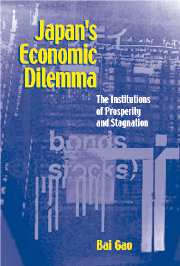Book contents
- Frontmatter
- Contents
- Acknowledgments
- 1 Introduction
- 2 Three Theoretical Issues
- 3 The Rise of the Principles of Coordination and Stability
- 4 Coordination, Excessive Competition, and High-Speed Economic Growth
- 5 Stability, Total Employment, and the Welfare Society
- 6 The Roads to the Bubble
- 7 The Struggle of the Welfare Society
- 8 Fighting the Stagnation
- References
- Index
4 - Coordination, Excessive Competition, and High-Speed Economic Growth
Published online by Cambridge University Press: 07 January 2010
- Frontmatter
- Contents
- Acknowledgments
- 1 Introduction
- 2 Three Theoretical Issues
- 3 The Rise of the Principles of Coordination and Stability
- 4 Coordination, Excessive Competition, and High-Speed Economic Growth
- 5 Stability, Total Employment, and the Welfare Society
- 6 The Roads to the Bubble
- 7 The Struggle of the Welfare Society
- 8 Fighting the Stagnation
- References
- Index
Summary
In 1950–1971, the Japanese economic system was reconfigured to cope with the new international economic order sustained by the Bretton Woods system and the GATT system. Because the purpose of coordination changed from, on the one hand, restoring economic order after the Great Depression and mobilizing resources for national survival during World War II to, on the other hand, promoting economic growth, the means of coordination also changed significantly. Unlike the situation in wartime, after 1952 the state no longer directly controlled the distribution of production materials and consumer products. Although the state still applied various policy tools to affect the behavior of private corporations, it could no longer use coercive power to achieve its goal. Sustained by the Bretton Woods system, the state was able to rely on an expansionary monetary policy to promote economic growth and meanwhile maintain a stable exchange rate with the dollar. Engaged in asymmetric cooperation with the United States, the state aimed at maximizing Japan's gains in international trade by promoting exports.
To coordinate national efforts to achieve economic growth, both the state and the private sector devised a number of important institutions and mechanisms. The Ministry of Finance practiced convoy administration, which was aimed at maintaining stability in the banking industry by restraining market entry and competition. To support aggressive lending by major city banks to manufacturers, the Bank of Japan supplied money, directly offering the banks credit and ensuring a minimum supply of credit. MITI not only adopted a pro–export development strategy, emphasizing the strategic allocation of foreign currencies to the heavy-chemical industries, but it also nurtured Japanese corporations in international competition by encouraging competitive oligopolies.
- Type
- Chapter
- Information
- Japan's Economic DilemmaThe Institutional Origins of Prosperity and Stagnation, pp. 68 - 113Publisher: Cambridge University PressPrint publication year: 2001



